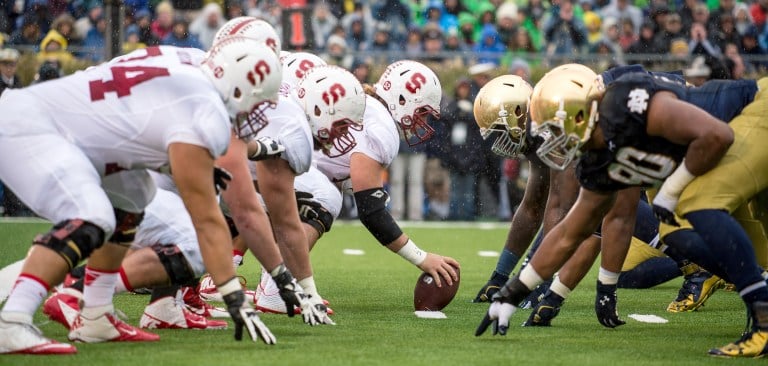With Stanford football set to open its season exactly one month from today, Daily football writers Michael Peterson, Do-Hyoung Park and Vihan Lakshman offered their opinions on several questions regarding the 2015 Stanford offense in the first part of their roundtable preview series for the Cardinal’s upcoming campaign.
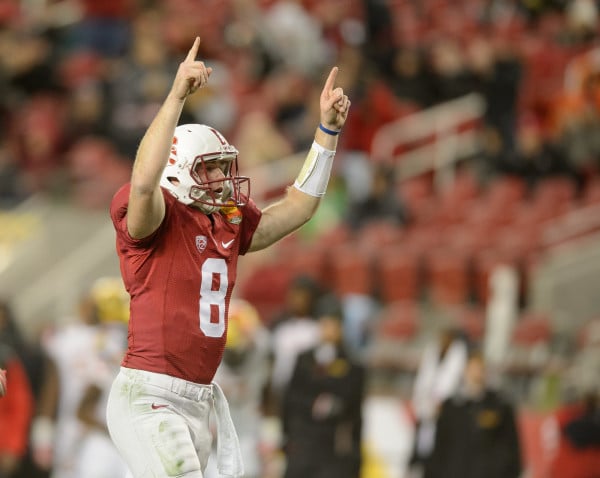
Can a notoriously inconsistent Hogan keep his late-2014 success going, or were those performances outliers?
Michael Peterson (MP): Hogan can absolutely replicate the overall performance he displayed late in 2014, but it would be unfair to him to expect gorgeous throws like the touchdowns he threw to Devon Cajuste and Michael Rector against UCLA on every play — he’s still going to make a few errant throws like we’ve seen throughout his career. However, Hogan demonstrated that with quality play from the offensive line and a decent running game, he can make all the throws Stanford needs to win and be dominant at times. That should continue in 2015.
Do-Hyoung Park (DHP): It’s been interesting to watch Hogan develop through his three years as a starter. In his 2012 and 2013 campaigns, he had a tremendous running game and offensive line but was held back by his playbook command and difficulty with his technique. Last year, he looked better mechanically and more comfortable in the system but was held back by a mental block (staring down Montgomery) and the pieces around him. This is the year it all comes together for Hogan — as a fourth-year starter, his playbook command and his improved mechanics will be at an all-time high, and all of the pieces around him will be running on all cylinders. Hogan will never be a world-beater, but he’ll be accurate and efficient. And that’s all Stanford needs.
Vihan Lakshman (VL): It’s easy to write off Hogan’s stellar finish to 2014 against Cal, UCLA and Maryland as a statistical aberration, but that would both discredit the huge strides Stanford made over the course of the season and overlook the challenges Hogan faced behind-the-scenes. Several reports have indicated that Hogan suffered a leg injury against Notre Dame, which clearly affected one of the hallmarks of his game: his mobility. We also know now that he played much of the 2014 season as his father battled cancer before passing away in early December. In short, those last three games for Hogan stand out as a triumph over adversity and the moment where the new-look offense began to click. Almost all of those key pieces return for the Cardinal, and Hogan personally is bringing a new level of confidence into the 2015 season. He won’t be a name at the center of the Heisman discussion, but he will bring years (wow, I feel old) of big-game experience and near-mastery of the playbook, which should give Stanford a huge boost.
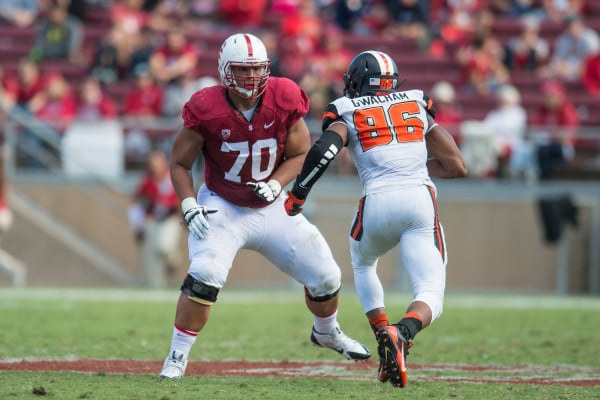
Biggest loss from the 2014 offense?
MP: Not to discredit the incredible play of Andrus Peat and Ty Montgomery, but Stanford’s offense appears perfectly capable of replacing both players’ production in 2015. All-Pac-12 tackle Kyle Murphy shifts into Peat’s old spot with former five-star recruit Casey Tucker likely to take over on the right side, and Stanford has Cajuste, Rector, Christian McCaffrey and four future NFL tight ends at its disposal in the passing game. Montgomery’s loss will hurt just a bit more now that Stanford no longer has a single receiver who clearly requires a double team, or at least extra attention.
DHP: I hate the cop-out answer, but I really can’t identify any of Stanford’s offensive losses as “big.” Like Michael said, the loss of Peat shouldn’t hurt the Cardinal too much since Stanford is stacked on the line and should be able to fill in at tackle adequately. I’m also not worried about the loss of Montgomery — as much as I hate to say it, Hogan seemed to go through his progressions much more effectively when Montgomery was hurt last year, making him a better quarterback. Lee Ward is also a big loss but Daniel Marx is a great fullback. If I really had to pick one, I’d have to go with Peat just because the depth on offensive line is least proven, particularly with the injury to Nick Davidson. But Stanford’s track record with offensive line health has always been pretty good, so I’m not horribly worried there either (knock on wood).
VL: There’s only one answer to this question. At 6-foot-7, 313 pounds, Peat is by far the “biggest” loss from the 2014 offense. Do and Michael are spot-on when they mention that Stanford’s envious offensive line depth, especially the number of underclassmen with game experience, will likely soften the blow of losing Stanford’s first top-15 NFL draft pick since Andrew Luck. Nevertheless, Peat is a special talent, who anchored the left side of the line since his sophomore year. Kyle Murphy and Casey Tucker are more than ready to step into their new roles, but that doesn’t discount the fact that losing a player of Peat’s caliber will always hurt.
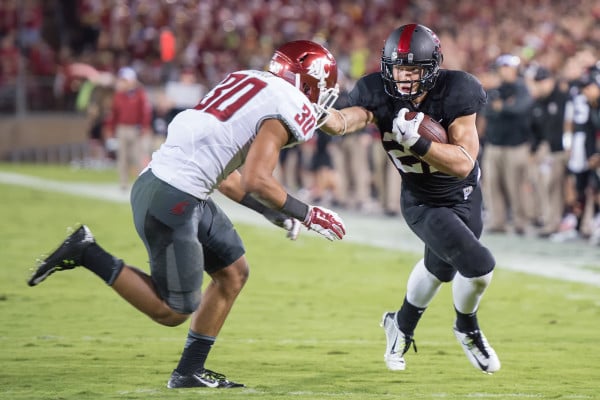
What is Christian McCaffrey’s role in the offense going to look like? What’s his ceiling?
MP: McCaffrey is now the Ty Montgomery of the offense, except as a much more frequent runner. Running up the middle, running to the outside, receiving screen and swing passes, lining up as a slot receiver, serving as the wildcat quarterback — it will all be used to get McCaffrey’s hands on the ball as often as possible. McCaffrey is one of the most valuable players in the Pac-12, and if Stanford gets him at least 20 touches a game as it should, he could be touted as one of the best all-around offensive players in the nation.
DHP: I’m really wary of the “get one guy the ball as much as possible” philosophy, because it really simplifies decision-making for defenses. I mean, just look at what happened last year with Ty — defenses knew that Stanford would try to force him the ball no matter what, so they doubled him and forced Hogan into bad, bad throws and decisions that could have been avoided without the “get Ty the ball no matter what” philosophy. I think McCaffrey should be kept in a similar role as last year — line him up in the slot occasionally, use him on perimeter runs, get him Wildcat touches — even if he isn’t the primary back out of Stanford’s backfield, there will be many, many opportunities to get him touches and make him into one of the Pac-12’s most dynamic threats. Just as long as Stanford doesn’t overdo it and try to force McCaffrey the ball when it shouldn’t.
VL: McCaffrey will likely enter the season as the centerpiece of an offense that makes no secret over what it hopes to do: run the ball down your throat. The sophomore running back has worked on bulking up in the offseason to handle the rigors of carrying a heavier load and becoming more adept in pass protection, a necessity for any feature back in David Shaw’s system. I’m actually a fan of the “get McCaffrey the ball as much as possible” strategy because, thus far, no team has proven it can stop him. More than seven yards per carry as a freshman, even with a limited amount of touches, is awfully impressive. McCaffrey also has a different skill set from Montgomery and won’t be involved in as many deep throws into double-coverage as Do alluded to. Instead, he will likely receive a steady diet of handoffs, pitches and screen passes, which should re-establish the run game and bring back the play-action pass, which went missing in 2014.

Will the presence of four highly-touted tight ends change Stanford’s offensive approach?
MP: If there’s any team in college football that knows how to effectively use four different tight ends, it’s Stanford. We should see Austin Hooper and Dalton Schultz split out wide more often, allowing Greg Taboada and Eric Cotton to join the tight-end party on the field lined up adjacent to the offensive line. Stanford certainly isn’t lacking for red-zone weapons this year and will have no excuse if poor play persists in the red zone.
DHP: I think each of them will have his own tightly-defined role. I don’t think Cotton will get as involved in the passing game, while Taboada will continue to see time in the red zone on fades and jump balls. I honestly have no idea how big of a role Schultz will have before fall practices start, so it’ll be really interesting for me to see if and how they work him into the offense. As for Hooper, well, I’ve made no secret of the fact that I think he’ll be one of the most effective players in the country this year. He’s effectively a second Devon Cajuste out there and eerily reminiscent of Zach Ertz, playing as a big possession receiver most of the time while also retaining lethal effectiveness in medium-to-deep passes up the seam. I don’t think the offense will be all too different from the end of last year, and that’s great, because that’s where Stanford is at its best.
VL: Stanford has been notorious in past seasons for putting out more formations than just about any team in the country, and having four play-making tight ends has to make the mad-scientist side of David Shaw a little giddy. We’ll see a lot of two- and three-tight end sets and maybe even all four on the field at once to throw defenses a look no one else in the Pac-12 can hope to replicate. I like Do’s point that Cotton, Hooper, Taboada and Schultz should each have well-defined roles, similar to what the Cardinal had with the Tree Amigos: Fleener was the burner on the outside, Ertz was the route-runner and Toilolo was the best blocker and jump-ball specialist. At this point, it’s a little too early to say where each of the current four will fit, but the possibilities certainly look appetizing.
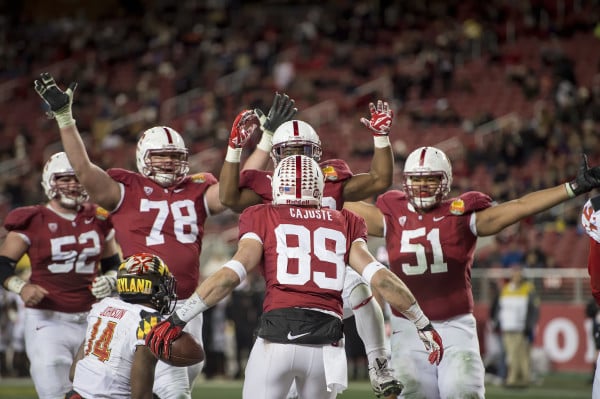
Can the offensive line return to the traditional dominance of old?
MP: The 2014 offensive line faced unrealistic expectations for essentially a group full of first-year starters due to the number of stars attached to its 2012 recruiting rankings. This time around, the unit appears to be in much better shape, with last year’s experience and three impeccable performances at the end of 2014 under its belt. Putting last year’s expectations on this group might result in more disappointment, but the offensive line should clearly improve and at least approach the success of past units, if not quite exceed that success as once expected.
DHP: Can it? Absolutely. On paper, this is one of the best offensive lines in the country. But as we saw last year, that doesn’t really mean much because the game isn’t played on paper. So will it return to traditional dominance? Unlike last year, I can’t see why not. If nothing changes from the end of last season and the line plays like it did against Cal, UCLA and Maryland, there aren’t many better units in the country. All it needs to do is keep up that form and stop committing stupid penalties (and given the significant experience the linemen have now, I think they should make significant strides in that area) and it should be fine.
VL: I don’t know about “return to the traditional dominance of old” because that’s a bar set awfully high, but I do expect 2015 edition of the Tunnel Workers’ Union to be among the best offensive lines in the conference and perhaps even the entire country. With the exception of Peat, all of the starters from last year’s unit are returning and we can’t understate how valuable that cohesion can be with the struggles we saw the young line face at the beginning of last season. The left side featuring Murphy and Josh Garnett will be something special, and I expect Stanford to routinely run the ball in that direction. I also expect the jumbo package to live on in all of its glory and Brandon Fanaika, a 6-foot-3, 321-pound sophomore, might become a household name when it comes to picking up those tough yards. Ultimately, Stanford’s O-line will be good in 2015, but there’s no need to keep comparing it to its predecessors.

Most likely newcomer to make an impact?
MP: A true freshman earning a consistent role on offense at Stanford is a rarity, despite McCaffrey’s showing last season, so while five-star receiver Trent Irwin brings great talent to the Farm, I don’t expect him to play a significant role in 2015. Former top tight-end recruit Dalton Schultz, ready for play after redshirting in 2014, should earn plenty of playing time, though. Even in the midst of three other talented tight ends, all signs point to Schultz being another star in the Cardinal’s long line of successful tight ends.
DHP: I’m going to go with the high-risk, high-reward pick in Isaiah Brandt-Sims. It’s easy to overlook him because of how deep Stanford’s receiving corps is, but I’m still shocked that nobody has been talking about the guy that’s been smashing Stanford sprinting records left and right. If used properly, he could be one of the most electric home-run threats on Stanford’s offense, and I’m really excited to see if and how he plays his role on the 2015 Cardinal. In terms of newcomers, I think he’s got the biggest impact potential. Schultz is a good pick, but I think his touches will be hard to come by with Austin Hooper set to become one of the top tight end producers in the nation. As a footnote, remember that Daniel Marx and Chris Harrell are the only listed fullbacks on the roster, meaning that I’d give incoming freshmen Reagan Williams and Houston Heimuli pretty good shots at seeing meaningful action as well.
VL: In the last decade, an average of four receivers per year have earned a five-star rating on 247Sports. Out of those receivers, a little over a quarter of them have gone on to make the NFL. Trent Irwin, labeled a five-star recruit by some experts, is obviously far from a lock to make it to the NFL or even guaranteed to play in his true freshman season, but the fact is that five-star receivers don’t grow on trees and Irwin’s talent is undeniable. With the loss of leading receiver Montgomery as well as sure-handed contributors in Jeff Trojan and Jordan Pratt, Stanford might be starving for an additional playmaker who can stretch the field and make plays down the stretch. At Pac-12 Media Day, Shaw even said that Irwin is the most likely freshman to see the field this season — and training camp hasn’t even started. It’s very possible that we won’t get a look at the jewel of the 2015 class until next season, but there’s definitely a chance he can make an impact this year.
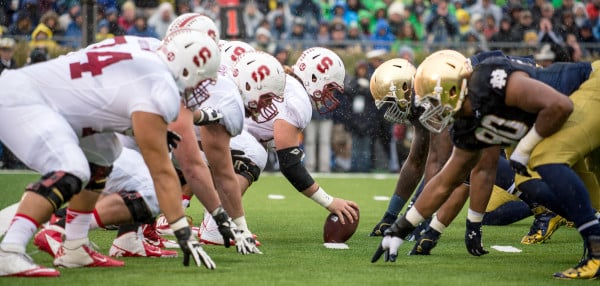
Player most critical to the offense’s success?
MP: The biggest difference in Stanford’s play over 2014’s final three games, in my opinion, was the performance of the offensive line. Stanford needs a similar high-level of play this year, and that all starts with left tackle Kyle Murphy. Murphy not only protects Hogan’s blind side but also paves the way for the running game, as the Cardinal will again look to run behind the left side because of Murphy, Josh Garnett and Graham Shuler. Succeed in that, and Stanford’s offense clicks just like in the conclusion of 2014.
DHP: I couldn’t agree more with Michael on this one. We saw last year just how critical the success of the offensive line is to Stanford’s offense. That will dictate how effectively the running backs are able to operate out of the backfield and how much time Hogan will have to set his feet and find his playmakers in space. I think the most important in there will be Josh Garnett. The guards play such an important position in Stanford’s offense due to the importance of the pulling offensive lineman in Stanford’s bread-and-butter power run, and Garnett in particular had major struggles with penalties last season, meaning that improvement in his discipline will make a huge difference in Stanford’s affinity for drawing the laundry this year.
VL: I’m going to go with senior wide receiver Michael Rector. After bursting on the scene in his redshirt freshman season with an insane 30.8 yards per catch, the explosive receiver started out a little slower in 2014 before — as with the rest of the offense — rebounding with a huge month of November, recording 11 catches for 120 yards. If Rector can continue to establish himself as one of the top receiving threats in the conference, Stanford will have another major weapon to turn to if teams start to lock in on the running game or direct more of their attention towards Devon Cajuste. This season could be a breakout one for Rector, one that could elevate this offense significantly.
Contact Michael Peterson at mrpeters ‘at’ stanford.edu, Do-Hyoung Park at dhpark ‘at’ stanford.edu and Vihan Lakshman at vihan ‘at’ stanford.edu.
